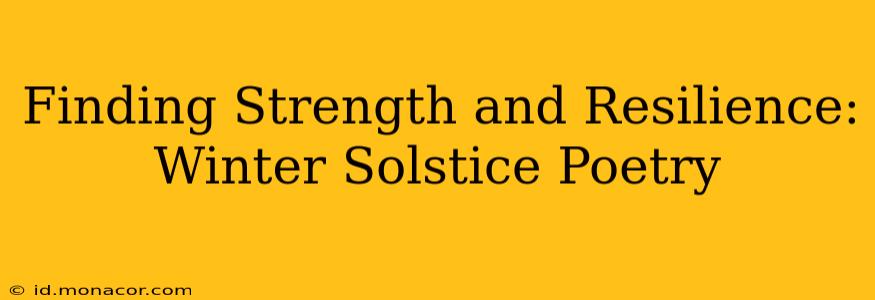The Winter Solstice, the shortest day of the year, often evokes feelings of darkness and despair. Yet, paradoxically, it also marks a turning point, a symbolic rebirth promising the return of the sun and the burgeoning of new life. This inherent duality makes it a potent source of inspiration for poets throughout history, who have used its imagery to explore themes of resilience, hope, and the enduring power of the human spirit. This exploration delves into the rich tapestry of winter solstice poetry, examining how poets have captured the essence of this significant time of year.
What is the significance of the Winter Solstice?
The Winter Solstice's significance stems from its astronomical position as the point in the year when the sun reaches its lowest point in the sky. In the Northern Hemisphere, this occurs around December 21st or 22nd. For millennia, cultures around the world have recognized this pivotal moment, marking it with festivals, rituals, and celebrations. The solstice represents the darkest time of the year, but it also holds the promise of returning light. This duality – the darkness preceding the dawn – offers a potent metaphor for overcoming adversity and finding strength in the face of challenges.
How do poets use imagery to represent the Winter Solstice?
Poets often utilize vivid imagery to capture the essence of the Winter Solstice. The stark, cold landscapes, the frozen rivers, the bare trees silhouetted against a pale sky, all become symbolic representations of the challenges and hardships faced in life. The darkness itself is not depicted solely as negative; instead, it’s portrayed as a necessary prelude to renewal, a time for introspection and inner growth. The imagery often shifts from bleakness to subtle hints of hope, mirroring the gradual lengthening of days following the solstice.
What are some common themes explored in Winter Solstice poetry?
Several recurring themes resonate strongly within winter solstice poetry:
-
Renewal and Rebirth: The solstice, signifying the sun's return, frequently serves as a metaphor for personal rebirth, spiritual renewal, and the cyclical nature of life and death. Poets explore the idea of letting go of the past and embracing new beginnings.
-
Resilience and Perseverance: The ability to endure hardship and emerge stronger is a prevalent theme. The enduring power of nature, surviving the harshest winter, inspires reflection on human resilience in the face of adversity.
-
Hope and Light: Even in the darkest hours, the promise of returning light remains a powerful source of hope. Poets often weave this theme into their work, highlighting the enduring power of optimism and faith.
-
Introspection and Reflection: The quiet stillness of the winter solstice encourages introspection. It's a time for self-examination, evaluating the past year, and setting intentions for the future.
-
Connection with Nature: The solstice is deeply connected to the natural world. Many poems emphasize the cyclical rhythms of nature, reminding us of our place within the larger ecosystem and the interconnectedness of all living things.
What are some examples of famous Winter Solstice poems?
While there isn't a single canon of "Winter Solstice poems," many poems allude to the themes and imagery associated with the solstice. Searching for poems related to "winter," "darkness," "rebirth," or "shortest day" will unearth numerous relevant examples. Exploring works by poets known for their engagement with nature and the cyclical rhythms of life will yield particularly fruitful results.
How can I write my own Winter Solstice poem?
Writing a Winter Solstice poem can be a deeply enriching experience. Start by observing your surroundings. Note the details of the winter landscape. Reflect on your own experiences and feelings associated with the season. Consider the themes of rebirth, resilience, hope, and introspection. Use vivid imagery and sensory details to bring your poem to life. Don't be afraid to experiment with different forms and styles. The most important element is to let your own unique voice and perspective shine through.
The Winter Solstice, a moment of profound significance, offers poets an opportunity to explore the complex interplay between darkness and light, despair and hope, death and rebirth. By reflecting on these powerful themes, poets create works that not only capture the essence of this pivotal time of year but also offer solace, inspiration, and a renewed sense of hope for the future.

